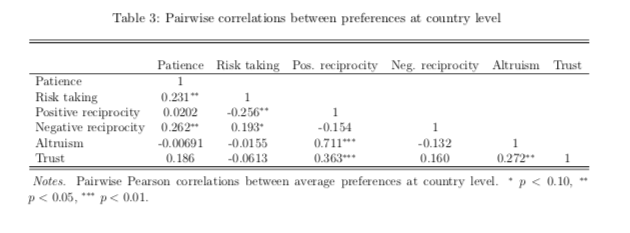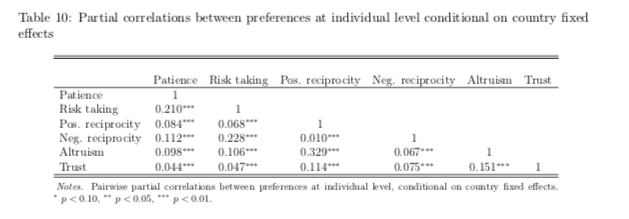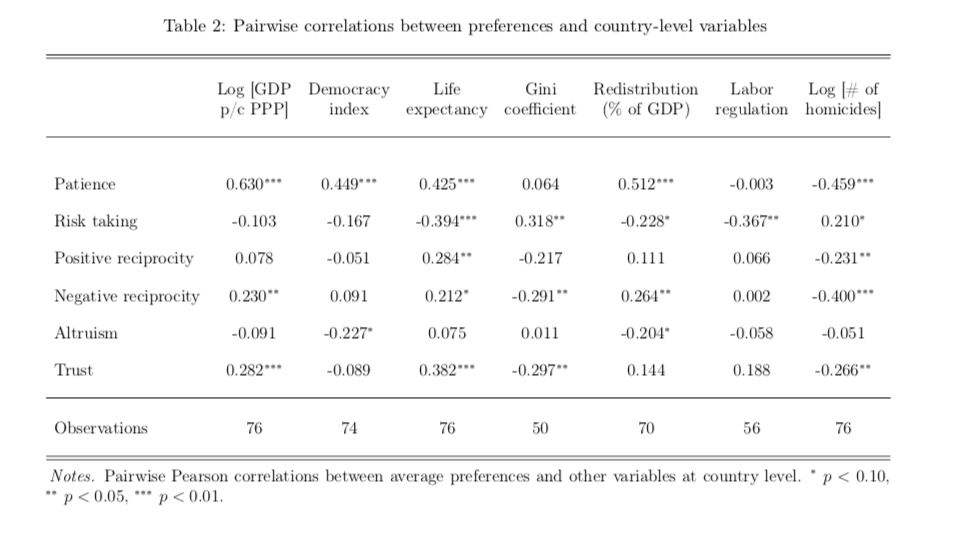Congratulations to all of you who guessed that I would fall behind in writing up these deep roots posts. I was able to get my notes together enough to cover material on culture during my class, but only now finally got around to writing this up as a post. This line of research is relatively new to me, so I’m going to apologize ahead of time for what is probably a less coherent take on the state of things than I’d like.
Guiso, Sapienza, and Zingales have a very nice paper on the relationship of culture and economic outcomes, although it is now over a decade old and thus missing out on some of the latest work in this area. Nevertheless, it gives a good idea of what we’re talking about here.
The aspect of culture most used by GSZ is trust, meaning generally a willingness to trust strangers (non-kin). I’m going to leave aside any question of causality of trust on economic outcomes for the moment, but for now let’s just note that the evidence shows this aspect of culture varies a lot across populations. Using data on immigrants to the US (thus holding constant the institutional and economic setting to some extent) they show that people self-report being willing to trust others.

What you can see are big differences, with those of Japanese and Scandanavian descent reporting much more trust, and those from South Asia, the Carribean, or Africa reporting much less. The fact that this varies so much is alone quite interesting, as it indicates substantial variation in something you might have guessed only varied across individuals, but not systematically across populations.
Moreover, eye-balling this figure you get a quick sense of why people latched onto culture as an explanation for economic outcomes. The level of reported trust almost looks like it was rank-ordered by the average GDP per capita of the origin countries of different ethnic groups. China is probably an outlier, but in general we see relatively rich places with high levels of trust.
In a nutshell, that is the kind of fact motivating this literature on culture and development. The idea is that there are certain cultural attitudes, or preferences, or norms, or what have you, that foster economic exchange, or innovation, or accumulation. Therefore development could be driven, in part, by having a specific culture that promotes those three things.
This sounds a lot like the argument about institutions, that some foster exchange, innovation, or accumulation more than others. And just like institutions, there is a definitional problem. What exactly counts as “culture”? For my own purposes, and for the purposes of this post, I tend to think of it in the following way. Economic development involves a series of constrained optimization problems, which implies a set of preferences and a set of constraints. Things like geography (for sure) and institutions (kind of) set the constraints. Culture (kind of) is related to the preferences.
Preference measures
We can look more carefully at people’s preferences along a variety of dimensions. One prime example of this is a recent paper on global preferences by Falk, Becker, Dohman, Enke, Huffman, and Sunde, which includes a fantastic site where you can download and use their data. FBDEHS worked with Gallup to run survey questions on preferences around the world, on a comparable basis, recovering about 80,000 individual responses in 76 countries.
They group the preferences into six types: patience, risk-taking, positive reciprocity, negative reciprocity, altruism, and trust. They use several questions to measure each of the six, and then combine the answers to those questions to get a single index of each one. A person’s risk-taking score, for example, depends on both a self-assessment as well as a value elicited from a standard set of questions asking that ask people to choose between a certain amount of money (e.g. $10) or a lottery (e.g. a coin flip for $25 or zero). The materials on their site have full information on how each of these was measured and validated.
Given the individual responses, they can do some simple country-level averages, and then look at how the different preferences correlate across countries. Their Table 3, shown here, shows those relationships. While there are a number of strong correlations here, it is not the case that these are perfectly related, meaning the six measures contain some distinct information. Patience and altruism, for example, are unrelated, implying one could think about them as different concepts. And given that kind of variation, it is at least plausible that one could identify different effects of patience and altruism on economic outcomes.

At the same time, there are some patterns that show up, or preferences that tend to move together. Trust, altruism, and positive reciprocity are all significantly and positively related, and one might term that package of preferences “prosociality”. Another set of characteristics that tend to move together are patience, risk-taking, and negative reciprocity. There is no obvious name for that correlation, although I’m tempted to call it “the revenant” because it calls to mind people willing to undertake a dangerous quest for revenge long after they are already dead. That is probably reading a little too much into the data, though.
More seriously, be very careful that this second set of correlations is not “antisocial”, because it is not the opposite of the prosocial characteristics. It is a different dimension along which people appear to vary. A country low in trust, altruism, and positive reciprocity would be “antisocial”, regardless of their patience, risk-taking, and negative reciprocity. One could also have a prosocial country that also rated high on the “revenant” characteristics.

FBDEHS also report similar correlations at individual level in their Table 10, which are interesting to compare to the country-level averages in the last table. Here, everything is signficant because they are using 80,000 individuals, but don’t let that distract you. What I see here is a weaker set of relationships, in terms of the size of the coefficients, but still some evidence of sets of characteristics. Prosociality appears again as a collection of positive reciprocity, altruism, and trust, and you also get the revenant package of patience, risk-taking, and negative reciprocity.
The numbers in this table are all excluding country fixed effects, meaning that they ignore the fact that in some countries that average level of trust, altruism, and positive reciprocity are high (and in others those are low), for example. These numbers show that taking those averages as given, within a country it also tends to be that people who trust more than average for their country also are more altruistic than the average for their country, and so on.
This leaves the comparison of the two tables. Table 10 tells us that the prosocial characteristics tend to move together across individuals within all countries. More altruistic people tend to be more trusting everywhere, for example. Similarly, in every country people who are more patient tend to favor more negative reciprocity. There is nothing about this, however, that necessarily implies that the cross-country average relationships in Table 3 have to arise. It is quite possible to have these individual correlations within every country, but for the average level of trust or patience to be similar across countries. That is, Table 10 could be true, but Table 3 could easily have been full of zeroes, or even negative relationships.
However, the numbers in Table 3 indicate that on top of those individual correlations, there is a similar pattern of variation in the average level of trust or patience (or any of the other characteristics) across countries as we see with individuals. That means that the raw correlations across all individuals in the FBDEHS sample that underlay the packages of traits (prosocial, revenant) are even stronger than what you see in the individual or country level alone.
From the perspective of research on the deep roots of comparative development, it is mainly the country-level variation that we’re interested in. And these preferences do appear correlated with country-level outcomes. FBDEHS look at raw correlations of each preference with several measures, which I cut and paste below.

There are strong correlations - and let’s be really clear here that these are correlations - of GDP per capita with patience, negative reciprocity, and trust. In fact, patience, negative reciprocity, and trust are the three traits that show up correlated with most of the other measures in the table: democracy, life expectancy, the Gini, and homicides. If we take high GDP per capita, high life expectancy, and few homicides as a rough gauge of development, then developed places tend to have two traits, patience and trust, and probably tend to be risk-averse and put a high weight on negative reciprocity. Keep in mind that there is nothing wrong with being both prosocial (trusting) and patient (a revenant), they are not mutually exclusive.
So here is the million-dollar question. Does being trusting and patient make you developed? Or does development make you trusting and patient? I am unaware of any clear evidence that answers these questions with any confidence. GSZ attempt to solve this causality problem by using religion to instrument for preferences. That … doesn’t make sense. It’s not any different than using say, the mortality of European settlers in different colonies to instrument for institutions, to pick a completely random example out of hat. In both cases, it is implausible that the only effect of the instrument (e.g. religion) on the outcome (e.g. savings rates, income redistribution) is through preferences.
Most research relies on what I’d call “verbal Granger causality”. The argument is that culture and preferences changes very slowly over time and were determined in the past. Therefore if we see a correlation of preferences with some economic outcome, it must be that the preference caused the economic outcome. But that isn’t quite right either. We know that history matters for economic outcomes, in the sense that past events can have persistent effects. So it is quite possible that there was some event in the “deep” past that made an economy poor, for example, and that also made its population less trusting of strangers, for example. The poverty persists, perhaps for reasons entirely unrelated to culture or preferences, and the lack of trust persists because cultural attitudes tend not to change much without a large shock. So when we look today, we see a poor country that is less trusting. But that doesn’t mean the lack of trust is why they are poor.
The danger here is that we’re doing ex post reasoning on cultural causes of development. Trust in strangers must be good for development because we see trust high in rich countries. Maybe trusting strangers is bad for development, but a host of other positive forces made trusting countries rich. Negative reciprocity is associated with higher GDP per capita, and you can tell yourself a story about why that could be. Perhaps because punishing cheaters deters others from cheating in the future, and that’s more important that rewarding good behavior (positive reciprocity). But if the coefficient on positive reciprocity had been significant, and that on negative reciprocity insignificant, you probably would have been just as happy with a story about how it is the rewards that matter more than the punishments. The point is that we don’t have any clear theory of which cultural preferences should be good for development, so we may just be making stuff up based on correlations.
Family structure
Keeping in mind the danger of ex post reasoning, and the lack of clear causal relationships, there is one aspect of culture that is of particular importance for studying development: family preferences. I’ve written on the blog a number of posts about how it is the change in the relationship of population growth and GDP per capita growth that generates sustained development, and not a specific technological revolution (e.g. steam engines). Thus cultural preferences regarding family size and structure can be crucial in understanding why some places developed earlier than others.
There are several papers out there now specifically looking at cultural differences in family preferences and modern outcomes. Benjamin Enke has a paper that looks at how family structure is related to cooperation and moral systems, while Jon Schulz has a paper that uses variation in exposure to the Catholic Church as an exogenous driver of differences in family structure, and hence of modern attitudes.
Both papers document in detail what an anthropologist would tell you, which is that the nature of family structure differs a lot across cultures. Nuclear families or clans? Do you trace relationships through the father, the mother, or both? Do new couples co-locate near one branch of the family or another? Are there dowries or bride prices? Is cousin-marriage encouraged or banned?
The answers to those questions matter to the extent that they affect preferences for familiy size or quality/quantity of kids. Alesina and Giuliano have a paper that looks at how variation in family structure (strong versus weak family ties is how they refer to it) affects fertility and several other outcomes. While those same authors along with Nunn have a paper on how plow use changed cultural attitudes towards fertility. The upshot of both is that these differences in preferences for family size are quite substantial.
These papers are probably underappreciated for their importance to the story of the take-off to sustained growth. Differences in fertility preferences would affect the level of living standards in Malthusian settings for sure. Beyond that, differences in fertility preferences, and in particular how sensitive fertility was to living standards, could influence whether a given culture took advantage of a technological or institutional or historical shock to make the move to sustained growth. I think this is a place where it might be useful to step back from the almost purely empirical work being done right now in the deep roots literature, and reconnect explicitly with the growth theory on the origins of take-offs. That theory could provide some guidance to what exactly we should be trying to measure when we talk about culture or preferences for family size.
Cultural variation
As a last point, let’s assume that there is something causal about culture (related to families or otherwise) for economic development. Why do those country-level preferences vary at all? Aren’t we all sort of the same? I’ve read some with these questions in mind, but not deeply. One place to start is this post by Pseudoerasmus, who takes a much deeper dive into the subject.
Two main theories about the deep roots of culture are “evolutionary psychology” and “cultural evolution”. The former thinks about how natural selection operated to create specific “hard-wired” mental structures in humans in response to their environment. The latter adds that culture itself - knowledge, norms, rules - evolve as well. From the perspective of someone reading the economics literature on deep origins of development, the distinction between these fields is not that important.
Why? Because for the purposes of the empirical work that people do in this area, it is environmental variation that is measurable and (arguably) exogenous. For the papers you’ll find in economics involving deep origins of culture, environmental characteristics are always on the right-hand side, and there is little to no explicit discussion of cultural evolution. Perhaps there is some hand-waving about how culture does evolve, but for the purposes of running some regressions, researchers almost always fall back on environmental features to explain (imperfectly, with R2 less than one) cultural variation.